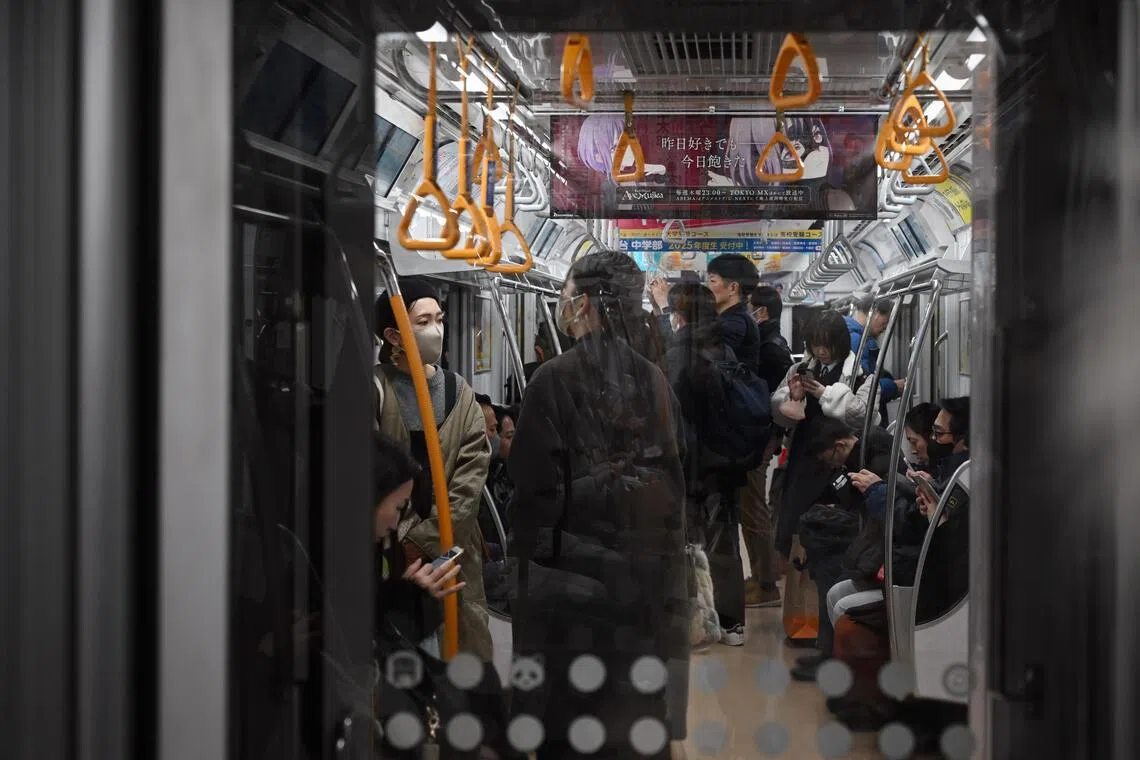Tokyo’s Yamanote Line to mark 100th anniversary of loop line operations
Sign up now: Get insights on Asia's fast-moving developments

Commuters travel in a train on the JR Yamanote Line, in Tokyo, on Feb 12.
ST PHOTO: KUA CHEE SIONG
Follow topic:
TOKYO - The JR Yamanote Line, which circles central Tokyo, will mark the 100th anniversary of the start of its operations as a complete loop on Nov 1.
By transporting large numbers of people and large volumes of freight, the Yamanote Line contributed significantly to the development of the capital and transformed the city itself, which has grown to be centered around its stations.
Even now, it continues to move forward into the future, taking on the challenge of introducing new operational technologies.
“It has been 100 years since the Yamanote Line became a loop line. As a railway professional, I am so proud that this line has served as a main artery (for Tokyo),” said Mr Yoichi Kise, president of East Japan Railway Co (JR East), at a regular press conference on Oct 7.
“We want local people to love it and use it for commuting to work and school, of course, but we also want to preserve it as a valuable tourism resource,” he added.
According to the Railway Museum in Saitama, the precursor to the Yamanote Line was the Shinagawa Line, which opened between Shinagawa and Akabane stations in 1885.
In 1909, the Shinagawa Line was connected to the Toshima Line, which ran between Tabata and Ikebukuro stations, and the combination of the two was named the Yamanote Line.
The line was gradually extended further, but the dense concentration of buildings in the area between Tokyo and Ueno stations for years made it impossible to build a rail link there. The situation was abruptly transformed by the Great Kanto Earthquake in 1923, opening the possibility for a section of elevated track to be completed in that part of the city in 1925.
This made the Yamanote Line into the full 34.5km loop that it is today.
Urban development
Although the Yamanote Line once primarily transported freight, it later shifted its focus to passenger transport.
After the Great Kanto Earthquake, many people relocated from central Tokyo to the western suburbs. Consequently, stations such as Shinjuku, Shibuya and Ikebukuro experienced a surge in commuters and students, particularly during the early Showa era (1926-89).
As private railways also built lines originating from these stations, they developed into major terminals.
The newest station on the Yamanote Line is Takanawa Gateway Station in Minato Ward, which opened in March 2020. A new era of urban development is steadily progressing nearby.
Part of the redevelopment area around the station, Takanawa Gateway City, opened in March. JR East has positioned this area as a place of experimentation, based around ideas about what life might be like 100 years from now.
Since September, an underground facility has been generating biogas from food waste in the area, for use in heating water at a nearby hotel.
Symbol of development
A JR East representative involved in managing the Yamanote Line said: “We will not cease evolving to fulfill the mission of our railway and provide a more comfortable experience for our passengers.”
One key initiative is the project to introduce driver-only operation of trains around 2030. The adoption of single-person operation on this high-frequency line is highly anticipated as a solution to future labour shortages.
As a safety measure, a monitor that allows the driver to observe passengers boarding and exiting will be installed in the driver’s cab. The company will also move ahead on improvements such as equipping their trains with automatic train operation systems, which automatically handle acceleration, deceleration and stopping.
Furthermore, JR East, as part of its mobility business growth strategy, announced in September, set a goal of having Yamanote Line trains operate automatically, with no licensed driver onboard, by 2035.
“The Yamanote Line is not just a means of transportation; it has significantly influenced the way the city is organised. It has been a symbol of Tokyo’s development in the past and will remain so in the future,” said Mr Satoshi Okuhara, 61, one of the chief curators at the Railway Museum. THE JAPAN NEWS/ASIA NEWS NETWORK

